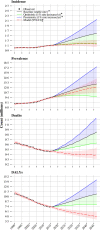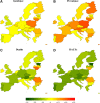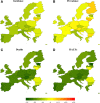Burden of Stroke in Europe: Thirty-Year Projections of Incidence, Prevalence, Deaths, and Disability-Adjusted Life Years
- PMID: 32646325
- PMCID: PMC7382540
- DOI: 10.1161/STROKEAHA.120.029606
Burden of Stroke in Europe: Thirty-Year Projections of Incidence, Prevalence, Deaths, and Disability-Adjusted Life Years
Abstract
Background and purpose: Prediction of stroke impact provides essential information for healthcare planning and priority setting. We aim to estimate 30-year projections of stroke epidemiology in the European Union using multiple modeling approaches.
Methods: Data on stroke incidence, prevalence, deaths, and disability-adjusted life years in the European Union between 1990 and 2017 were obtained from the global burden of disease study. Their trends over time were modeled using 3 modeling strategies: linear, Poisson, and exponential regressions-adjusted for the gross domestic product per capita, which reflects the impact of economic development on health status. We used the Akaike information criterion for model selection. The 30-year projections up to 2047 were estimated using the best fitting models, with inputs on population projections from the United Nations and gross domestic product per capita prospects from the World Bank. The technique was applied separately by age-sex-country groups for each stroke measure.
Results: In 2017, there were 1.12 million incident strokes in the European Union, 9.53 million stroke survivors, 0.46 million deaths, and 7.06 million disability-adjusted life years lost because of stroke. By 2047, we estimated an additional 40 000 incident strokes (+3%) and 2.58 million prevalent cases (+27%). Conversely, 80 000 fewer deaths (-17%) and 2.31 million fewer disability-adjusted life years lost (-33%) are projected. The largest increase in the age-adjusted incidence and prevalence rates are expected in Lithuania (average annual percentage change, 0.48% and 0.7% respectively), and the greatest reductions in Portugal (-1.57% and -1.3%). Average annual percentage change in mortality rates will range from -2.86% (Estonia) to -0.08% (Lithuania), and disability-adjusted life years' from -2.77% (Estonia) to -0.23% (Romania).
Conclusions: The number of people living with stroke is estimated to increase by 27% between 2017 and 2047 in the European Union, mainly because of population ageing and improved survival rates. Variations are expected to persist between countries showing opportunities for improvements in prevention and case management particularly in Eastern Europe.
Keywords: global burden of disease; health status; incidence; prevalence; stroke.
Figures





References
-
- Wilkins E, Wilson L, Wickramasinghe K, Bhatnagar P, Leal J, Luengo-Fernandez R, Burns R, Rayner M, Townsend N. European Cardiovascular Disease Statistics 2017. Brussels: European Heart Network; 2017.
-
- Béjot Y, Bailly H, Durier J, Giroud M. Epidemiology of stroke in Europe and trends for the 21st century. Presse Med 20164512 pt 2e391–e398doi: 10.1016/j.lpm.2016.10.003 - PubMed
-
- OECD. In: Health at a Glance: Europe 2016: State of Health in the EU Cycle. Paris: OECD Publishing; 2016. Mortality from heart disease and stroke.
-
- Bennett DA, Krishnamurthi RV, Barker-Collo S, Forouzanfar MH, Naghavi M, Connor M, Lawes CM, Moran AE, Anderson LM, Roth GA, et al. ; Global Burden of Diseases, Injuries, and Risk Factors 2010 Study Stroke Expert Group The global burden of ischemic stroke: findings of the GBD 2010 study. Glob Heart 20149107–112doi: 10.1016/j.gheart.2014.01.001 - PubMed

